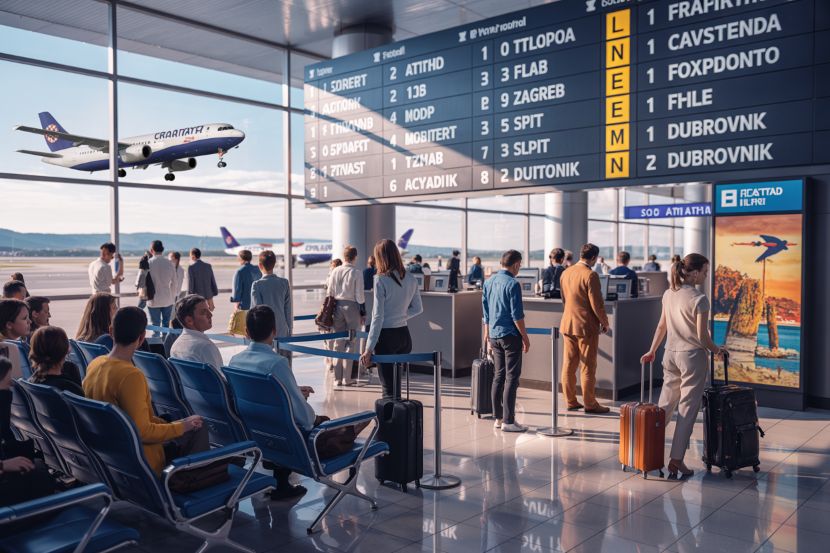Published on
October 16, 2025
Croatia is making waves in the European aviation sector, joining Cyprus, Finland, Malta, Greece, and Lithuania in recording a significant increase in flight traffic. With a 19% rise in air traffic compared to pre-pandemic levels, Croatia is solidifying its position as a key player in both tourism and business travel in Europe. The Adriatic region, renowned for its stunning coastline, historic cities, and vibrant culture, is now more connected than ever before, thanks to enhanced airline services and the country’s growing popularity as a destination for both leisure and corporate travel.
This growth in air traffic reflects a broader trend across Europe, where countries like Cyprus and Greece have also experienced major increases in flights, driven by the recovery of the tourism industry. As the world emerges from the pandemic, these nations have ramped up their flight networks to meet the growing demand for international travel, making it easier for tourists and business professionals to explore these regions.
Flight Growth in Croatia: A Testament to the Country’s Popularity
According to the Eurostat data, Croatia’s flight performance stands out in Europe, with an increase of 19% in flight numbers compared to 2019, surpassing many European nations, including Greece (+21%), Poland (+22%), and Malta (+19%). This increase can be attributed to Croatia’s continued rise as a tourism hotspot, attracting both holidaymakers and business travelers. With its pristine Adriatic coastline, charming towns like Dubrovnik and Split, and vibrant culture, Croatia remains one of the most sought-after destinations for European and international travelers.
The recovery in flights coincides with a broader tourism boom in Croatia, with its UNESCO World Heritage Sites, picturesque beaches, and increasing direct flight connectivity from major European cities.
Why Croatia’s Air Traffic Recovery Is Important for Business and Leisure Travel
The robust growth in air traffic from Croatia presents significant advantages for both business and leisure travelers. For business professionals, the ease of direct flights to Croatia from Europe’s major hubs is vital for accessing the country’s thriving conference and business meeting scene. The increased number of international flights strengthens Croatia’s position as a growing business destination, particularly in Zagreb, the country’s capital and economic center.
For tourists, Croatia’s growth in flight capacity means more affordable and convenient access to the country’s top destinations. The strong rebound in air traffic not only highlights Croatia’s success in attracting visitors but also supports the local economy through tourism spending.
Comparing Flight Growth Across Europe: Croatia Among the Leaders
While many countries in Europe are seeing a recovery in air travel, some are experiencing slower progress. Countries like Latvia (-30%), Sweden (-27%), and Finland (-24%) reported some of the largest decreases in flights, continuing to feel the lingering effects of the pandemic. This stark contrast emphasizes the importance of a country’s tourism infrastructure and the ability to adapt to changing global circumstances. Croatia’s growth is a prime example of how tourism and business initiatives have fueled air traffic recovery in the post-pandemic era.
Despite this positive trend, Croatia’s air traffic remains below pre-pandemic levels, with overall flight numbers in Europe still about 1.8% below 2019 figures. However, the significant growth in countries like Croatia signals renewed optimism and highlights the resilience of European destinations in rebuilding their tourism sectors.
What Tourists and Business Travelers Can Expect in Croatia
For business travelers, the increased flight connectivity means easier access to meetings, events, and conferences in major Croatian cities such as Zagreb and Dubrovnik. Whether attending industry events or seeking new business opportunities in the Adriatic, Croatia is an attractive destination for professionals.
For tourists, this flight growth translates into more affordable travel options and better connectivity to Croatia’s islands, coastal towns, and historic sites. Whether travelers are visiting Dubrovnik for its medieval beauty, hiking the Plitvice Lakes National Park, or enjoying the beaches of Split, the growing number of flights ensures a seamless travel experience.
Quick Tips for Traveling to CroatiaBook Flights Early: While the increase in flights has made Croatia more accessible, booking early can help secure the best prices and seats, especially during peak tourist seasons.Check the Flight Status: Due to increased flight frequency, it’s essential to check flight schedules on platforms like Eurostat or your airline’s website for real-time updates.Consider Alternative Airports: If you are flying to Croatia for a business trip, consider flying into Zagreb or Split for greater convenience, depending on your final destination.Explore Regional Destinations: Croatia’s growth in air traffic means more flights to regional hubs like Pula and Zadar, so don’t miss out on exploring hidden gems beyond the popular cities.Travel Insurance: With unpredictable weather conditions and the possibility of flight disruptions, it’s always wise to opt for travel insurance to ensure you’re covered.Key Points to Remember:Croatia recorded a 19% increase in flight traffic compared to 2019, showing strong recovery in air travel.The growth in flights from European hubs makes Croatia an attractive destination for both business travelers and tourists.Some countries, like Latvia and Sweden, continue to see declines in air traffic, highlighting Croatia’s success in rebuilding its travel infrastructure.Zagreb, Dubrovnik, and Split are top business and leisure destinations in Croatia, benefitting from the increased flight frequency.
